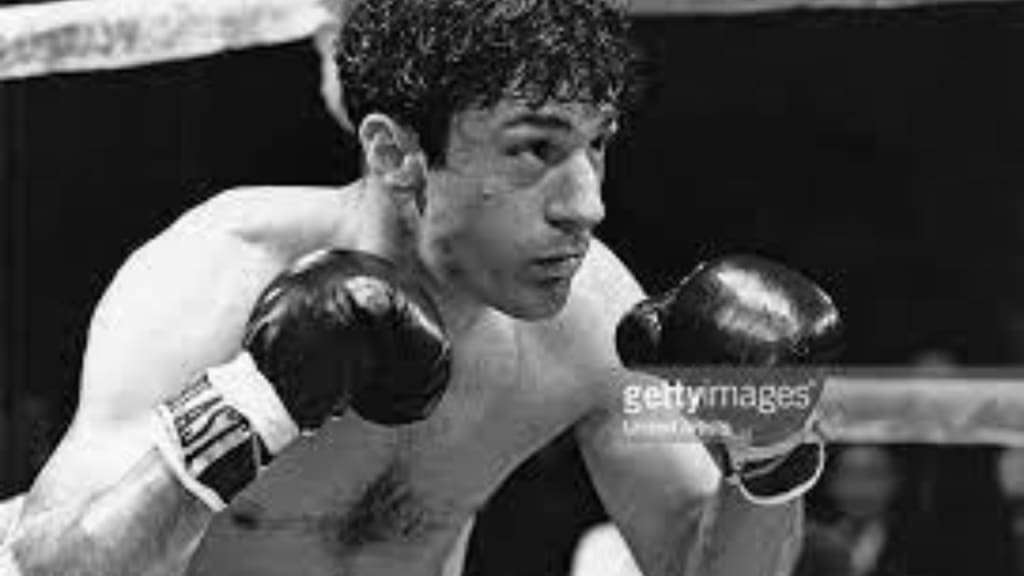Raging Bull (1980) Review
1980 American biographical sports drama film directed by Martin Scorsese

Raging Bull is a 1980 film directed by Martin Scorsese and starring Robert De Niro as real-life boxer Jake LaMotta. The film is based on LaMotta's memoir, Raging Bull: My Story, and tells the story of his rise to fame as a boxer and his subsequent downfall due to his violent and self-destructive behavior. The film is widely regarded as one of the greatest sports films ever made, as well as one of Scorsese's best films.
One of the most striking aspects of Raging Bull is its use of black and white cinematography. The film's stark, high-contrast visuals create a sense of gritty realism that perfectly captures the world of boxing in the 1940s and 50s. The film's boxing scenes are particularly well-shot, with Scorsese using a mix of slow-motion, high-speed, and handheld camera techniques to create a sense of visceral energy and intensity. These scenes are some of the film's most memorable, and they have become iconic in the world of sports cinema.
Another strength of Raging Bull is its strong performances, particularly from Robert De Niro in the lead role of Jake LaMotta. De Niro gives an unforgettable performance as LaMotta, capturing both his brutal physicality and his emotional turmoil. He gained over 50 pounds to play LaMotta in his later years, and his transformation is both impressive and disturbing. De Niro's performance is one of the greatest in the history of sports cinema, and it earned him a well-deserved Academy Award for Best Actor.
The film's supporting cast is also excellent, with standout performances from Joe Pesci as LaMotta's brother and manager Joey, and Cathy Moriarty as LaMotta's wife Vickie. Pesci brings both humor and pathos to the role of Joey, who is both supportive and manipulative of his brother. Moriarty, in her feature film debut, gives a stunning performance as Vickie, capturing both her beauty and her strength in the face of LaMotta's violent behavior.
One of the most interesting aspects of Raging Bull is its exploration of masculinity and violence. The film portrays LaMotta as a deeply flawed and violent man, who is driven by his own insecurities and inner demons. His violent behavior towards his wife and his opponents is both disturbing and heartbreaking, and the film does not shy away from portraying the consequences of his actions. Through LaMotta's story, the film asks important questions about the nature of masculinity, and the ways in which violence and aggression can be destructive to both individuals and society as a whole.
Another notable aspect of Raging Bull is its use of sound. The film's sound design is both subtle and effective, with the sounds of punches landing and crowds cheering adding to the film's sense of realism and intensity. The film's use of music is also noteworthy, with the haunting strains of Pietro Mascagni's "Cavalleria rusticana" serving as a recurring theme throughout the film. The film's final scene, in which LaMotta rehearses his nightclub act alone in his dressing room, is a masterclass in the use of sound and music in film.
While Raging Bull is a powerful and well-made film, it is not without its flaws. Some critics have noted that the film's portrayal of LaMotta is overly sympathetic, and that it fails to fully explore the darker aspects of his character. Additionally, some have criticized the film's portrayal of women, arguing that it is sexist and one-dimensional.
Despite these criticisms, Raging Bull remains a powerful and unforgettable film. Its use of black and white cinematography, strong performances, and exploration of masculinity and violence make it a must-see for fans of sports cinema and political films. Its themes are as relevant today as they were when the film was first released in 1980, and its portrayal of the destructive nature of violence and the importance of self-reflection and redemption is timeless.
In conclusion, Raging Bull is a masterful work of cinema that has rightly earned its place as one of the greatest sports films ever made. Martin Scorsese's direction, Robert De Niro's performance, and the film's stunning visual style all contribute to making it a truly unforgettable experience. While it is not without its flaws, the film's exploration of masculinity, violence, and redemption makes it a timeless classic that continues to resonate with audiences today. Whether you are a fan of sports cinema, Martin Scorsese, or Robert De Niro, Raging Bull is a film that should not be missed.





Comments
There are no comments for this story
Be the first to respond and start the conversation.